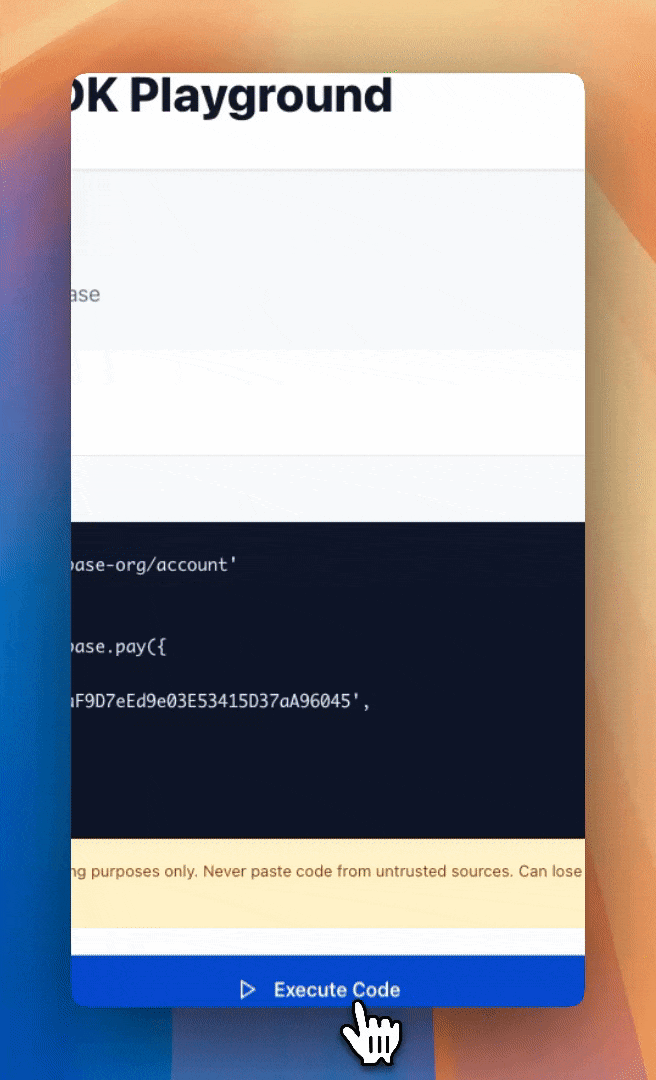Why Base Pay?
USDC on Base is a fully-backed digital dollar that settles in seconds and costs pennies in gas. Base Pay lets you accept those dollars with a single click—no cards, no FX fees, no chargebacks.
- Any user can pay – works with every Base Account (smart-wallet) out of the box.
- USDC, not gas – you charge in dollars; gas sponsorship is handled automatically.
- Fast – most payments confirm in <2 seconds on Base.
- Funded accounts – users pay with USDC from their Base Account or Coinbase Account.
- No extra fees – you receive the full amount.
Please Follow the Brand GuidelinesIf you intend on using the BasePayButton, please follow the Brand Guidelines to ensure consistency across your application. Client-side (Browser SDK)
Interactive Playground: Try out the pay() and getPaymentStatus() functions in our Base Pay SDK Playground before integrating them into your app.
import { pay, getPaymentStatus } from '@base-org/account';
// Trigger a payment – user will see a popup from their wallet service
try {
const payment = await pay({
amount: '1.00', // USD amount (USDC used internally)
to: '0xRecipient', // your address
testnet: true // set false for Mainnet
});
// Option 1: Poll until mined
const { status } = await getPaymentStatus({
id: payment.id,
testnet: true // MUST match the testnet setting used in pay()
});
if (status === 'completed') console.log('🎉 payment settled');
} catch (error) {
console.error(`Payment failed: ${error.message}`);
}
Important: The testnet parameter in getPaymentStatus() must match the value used in the original pay() call. If you initiated a payment on testnet with testnet: true, you must also pass testnet: true when checking its status.
payerInfo object:
try {
const payment = await pay({
amount: '25.00',
to: '0xRecipient',
payerInfo: {
requests: [
{ type: 'email' },
{ type: 'phoneNumber', optional: true },
{ type: 'physicalAddress', optional: true }
],
callbackURL: 'https://your-api.com/validate' // Optional - for server-side validation
}
});
console.log(`Payment sent! Transaction ID: ${payment.id}`);
// Log the collected user information
if (payment.payerInfoResponses) {
if (payment.payerInfoResponses.email) {
console.log(`Email: ${payment.payerInfoResponses.email}`);
}
if (payment.payerInfoResponses.phoneNumber) {
console.log(`Phone: ${payment.payerInfoResponses.phoneNumber.number}`);
console.log(`Country: ${payment.payerInfoResponses.phoneNumber.country}`);
}
if (payment.payerInfoResponses.physicalAddress) {
const address = payment.payerInfoResponses.physicalAddress;
console.log(`Shipping Address: ${address.name.firstName} ${address.name.familyName}, ${address.address1}, ${address.city}, ${address.state} ${address.postalCode}`);
}
}
} catch (error) {
console.error(`Payment failed: ${error.message}`);
}
| type | returns |
|---|
email | string |
name | { firstName, familyName } |
phoneNumber | { number, country } |
physicalAddress | full address object |
onchainAddress | string |
Required by default — set optional: true to avoid aborting the payment if the user declines.
How to validate the user’s information?You can use the callbackURL to validate the user’s information on the server side.Learn more about this in the callbackURL reference. Polling example
import { getPaymentStatus } from '@base-org/account';
export async function checkPayment(txId, testnet = false) {
const status = await getPaymentStatus({
id: txId,
testnet // Must match the testnet setting from the original pay() call
});
if (status.status === 'completed') {
// fulfil order
}
}
import { BasePayButton } from '@base-org/account-ui/react';
import { pay } from '@base-org/account';
export function Checkout() {
const handlePayment = async () => {
try {
const payment = await pay({ amount: '5.00', to: '0xRecipient' });
console.log(`Payment sent! Transaction ID: ${payment.id}`);
} catch (error) {
console.error(`Payment failed: ${error.message}`);
}
};
return (
<BasePayButton
colorScheme="light"
onClick={handlePayment}
/>
);
}
Please Follow the Brand GuidelinesIf you intend on using the BasePayButton, please follow the Brand Guidelines to ensure consistency across your application. Test on Base Sepolia
-
Get test USDC from the Circle Faucet (select “Base Sepolia”).
-
Pass
testnet: true in your pay() and getPaymentStatus() calls.
-
Use Sepolia BaseScan to watch the transaction.
